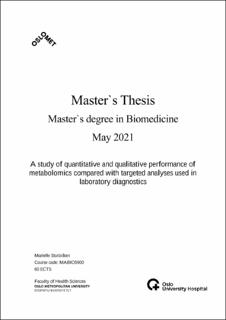| dc.description.abstract | Today, several specific and targeted analyses are used for detection of different chemical compounds and diagnostics of inborn errors of metabolism (IEMs). Metabolomics, an untargeted analytical approach, has been used as a supplement to established targeted analytical approaches in diagnostic laboratories for more effective diagnostics of IEMs. However, little is known regarding the quantitative performance of metabolomics, and a higher level of confidence is needed for metabolite identification. A metabolomics method that is well suited for easily accessible biological materials e.g. urine and plasma is an advantage. The aim of this study was to evaluate the quantitative and qualitative performance of the established metabolomics method HPLC – ESI – Q Exactive Orbitrap MS studying amino acids and amino acid related compounds, diagnostic markers, in urine and plasma samples. Almost all the selected compounds were identified with level 1 identification, the highest level of confidence, using the in-house library that was created in this thesis. The in-house library will be used for identification of amino acids and related compounds in future metabolomics studies. The metabolomics method is a useful diagnostic tool, as the diagnostic metabolite PEA, which is not quantified by established targeted methods in the diagnostic laboratory of IEMs at Oslo University Hospital – Rikshospitalet, was successfully detected. The precision of the metabolomics method was good for most of the selected compounds in urine and in plasma (retention time <2%, and peak area <30% RSD). Urinary metabolites were normalized to creatinine concentration, and the correlation between amino acid peak area from metabolomics and measured concentration ratios from targeted analyses was found. The correlation was better in samples diluted to 0.1 mM creatinine than to higher creatinine concentrations, and approximately linear. This correlation was also found comparing diagnostic markers for cystinuria in normal urine samples to a pathologic sample, and in samples spiked with different concentrations of PEA representing normal samples and HPP. However the qualitative performance of the metabolomics method was better when urine samples were diluted to 2 mM creatinine. Furthermore, several of the selected compounds were affected by chromatographic matrix effects, ion suppression or ion enhancement in plasma. Less variation was found in plasma samples than in urine samples. This study showed that metabolomics is a useful tool for diagnostics of IEMs, e.g. HPP and cystinuria, but it is important to remember that at higher matrix concentrations, matrix effects can cause false positive and negative results. | en_US |
